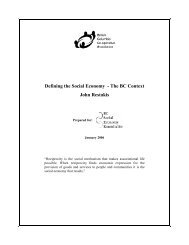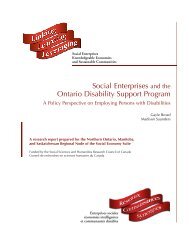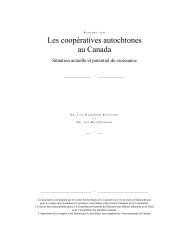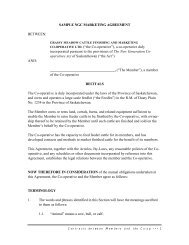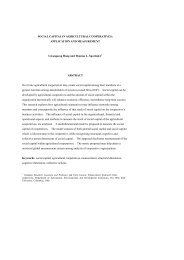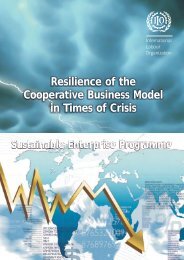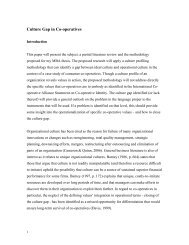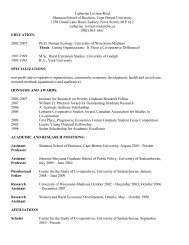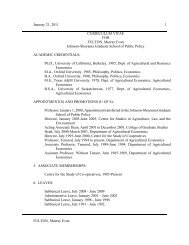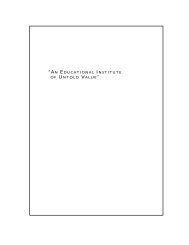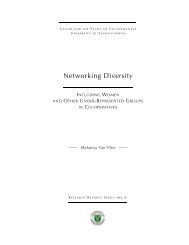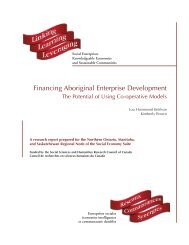Aboriginal Co-operatives in Canada - Centre for the Study of Co ...
Aboriginal Co-operatives in Canada - Centre for the Study of Co ...
Aboriginal Co-operatives in Canada - Centre for the Study of Co ...
Create successful ePaper yourself
Turn your PDF publications into a flip-book with our unique Google optimized e-Paper software.
~ C O - O P S I N Q U É B E C A B O R I G I N A L C O M M U N I T I E Sorganizational structure <strong>of</strong> Nunavik co-<strong>operatives</strong>. The figures <strong>the</strong>y present are <strong>of</strong> butlimited use to us today, s<strong>in</strong>ce <strong>the</strong>y no longer reflect <strong>the</strong> current situation. For this purpose,one would do much better to consult <strong>the</strong> m<strong>in</strong>utes and annual reports <strong>of</strong> <strong>the</strong> Fédération descoopératives du Nouveau-Québec, <strong>for</strong> that is where <strong>the</strong> most recent data are to be found.The great majority <strong>of</strong> <strong>the</strong> works on economic development <strong>in</strong> Nunavik were produced toolong ago—most <strong>of</strong> <strong>the</strong>m <strong>in</strong> <strong>the</strong> eighties—to <strong>of</strong>fer pr<strong>of</strong>iles <strong>of</strong> any validity today.Accord<strong>in</strong>g to <strong>the</strong> <strong>in</strong><strong>for</strong>mation <strong>in</strong> <strong>the</strong> m<strong>in</strong>utes <strong>of</strong> <strong>the</strong> general assembly <strong>of</strong> <strong>the</strong> Fédération descoopératives du Nouveau-Québec held from April 4–11, 2000 (FCNQ 2000 (b)), sales <strong>of</strong>Inuit carv<strong>in</strong>gs seem to be one <strong>of</strong> <strong>the</strong> major current concerns <strong>of</strong> <strong>the</strong> Nunavik co-<strong>operatives</strong>.For some years now, <strong>the</strong> fédération has been encounter<strong>in</strong>g substantial problems <strong>in</strong> sell<strong>in</strong>g<strong>the</strong>se carv<strong>in</strong>gs, which are said to be sometimes <strong>of</strong> mediocre quality. The quality <strong>of</strong> <strong>the</strong>carv<strong>in</strong>gs is, <strong>in</strong> fact, a major, recurr<strong>in</strong>g problem. As a result, <strong>the</strong> fédération is <strong>for</strong>ced to sell<strong>the</strong>m at a discount, which affects not only sales and f<strong>in</strong>ances but also <strong>the</strong> image <strong>of</strong> Nunavikart.In recent years, <strong>the</strong> co-<strong>operatives</strong> have also developed tourism packages to nor<strong>the</strong>rnQuébec. This sector is do<strong>in</strong>g very well. For <strong>the</strong> year 2000, 191 hunt<strong>in</strong>g trips and 138fish<strong>in</strong>g trips have been reserved, represent<strong>in</strong>g about 65 percent <strong>of</strong> <strong>the</strong> excursions available(FCNQ 2000 (b), p. 29). The sector is experienc<strong>in</strong>g certa<strong>in</strong> growth pa<strong>in</strong>s, however, due toa lack <strong>of</strong> adequate guide tra<strong>in</strong><strong>in</strong>g. Lack <strong>of</strong> tra<strong>in</strong><strong>in</strong>g among co-operative employees andgeneral management is ano<strong>the</strong>r constant concern. Accord<strong>in</strong>g to Investissement Québec(telephone conversation, 2000), which grants loan guarantees to <strong>the</strong> co-<strong>operatives</strong> <strong>of</strong> NewQuébec, <strong>the</strong> two ma<strong>in</strong> causes <strong>of</strong> <strong>the</strong> poor operation <strong>of</strong> certa<strong>in</strong> co-<strong>operatives</strong> are unskilledpersonnel (it identifies, <strong>in</strong> particular, shortcom<strong>in</strong>gs at <strong>the</strong> general management level) andcompetition from <strong>the</strong> North West <strong>Co</strong>mpany (<strong>for</strong>merly <strong>the</strong> Hudson’s Bay <strong>Co</strong>mpany) <strong>in</strong>certa<strong>in</strong> villages.The <strong>Co</strong>-<strong>operatives</strong> <strong>in</strong> <strong>the</strong> South<strong>Co</strong>-operative experiences south <strong>of</strong> <strong>the</strong> 55th parallel have not received any thorough study.There is some literature, however, on <strong>in</strong>dividual entrepreneurship on Native reserves <strong>in</strong>Québec. Harold Bherer is key figure <strong>in</strong> this regard. In his work Wampum and LettersPatent, Bherer analyzes <strong>the</strong> entrepreneurial development <strong>of</strong> Native communities <strong>in</strong> terms<strong>of</strong> different variables such as geographic location, culture and traditions, and naturalresources (Bherer et al. 1990). <strong>Co</strong>mpany objectives, <strong>the</strong>re<strong>for</strong>e, vary depend<strong>in</strong>g on <strong>the</strong>geographic, demographic, and cultural characteristics <strong>of</strong> each Native community. Bherernone<strong>the</strong>less manages to identify certa<strong>in</strong> common features <strong>of</strong> bus<strong>in</strong>ess development <strong>in</strong><strong>Aborig<strong>in</strong>al</strong> communities.~ 223




